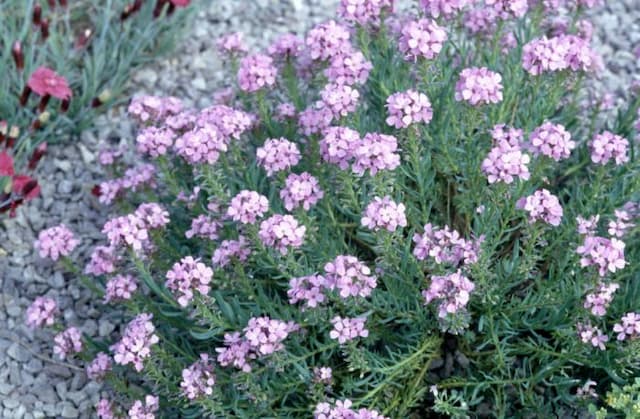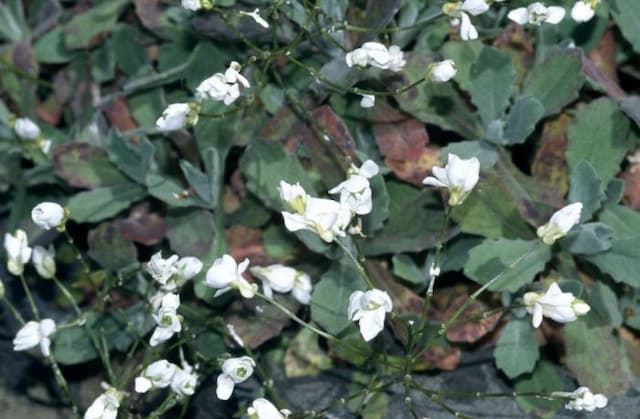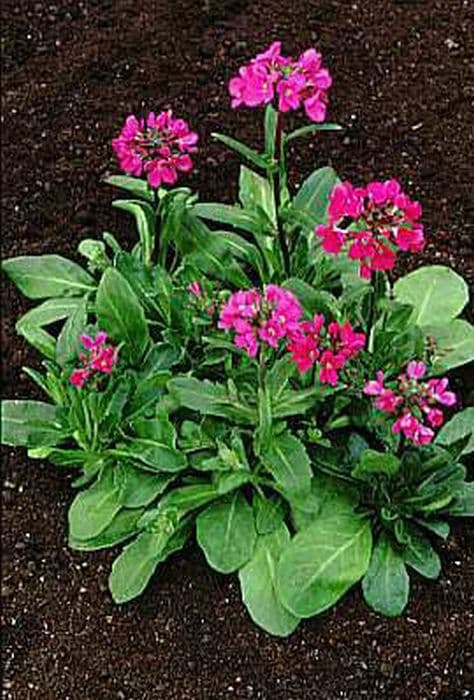Rock Cress Aubrieta gracilis 'Kitte'

ABOUT
Aubrieta gracilis 'Kitte' is a perennial plant known for its charming and vibrant appearance. This particular variety is adorned with small, rounded leaves that have a subtle, downy texture. These leaves often display a rich, green hue that serves as a lush backdrop for the plant's enchanting floral display. The flowers of 'Kitte' are remarkable, showcasing a profusion of dainty blooms that form a dense mat across the foliage. The blossoms are notable for their vivid purple shade, typically with a lighter center or eye, which adds depth and contrast to the floral array. The overall growth habit of Aubrieta gracilis 'Kitte' exudes a cascading or trailing effect, making it a delightful candidate for rock gardens, border fronts, or as an ornamental covering over walls or slopes. The plant's ability to produce an abundance of flowers gives it a significant visual impact, where it creates a delightful carpet of color during its blooming season.
About this plant
 Names
NamesFamily
Brassicaceae
Synonyms
Rock Cress, False Rockcress
Common names
Aubrieta gracilis.
 Toxicity
ToxicityTo humans
The plant commonly known as rock cress is not known to be toxic to humans. Ingesting parts of this plant is unlikely to cause poisoning or serious side effects. However, as with any plant, individual allergies and sensitivities might occur, and it is generally advised not to consume plant material that is not known to be edible.
To pets
Rock cress is also not known to be toxic to pets. It should not cause any serious symptoms of poisoning if ingested by animals such as cats and dogs. As with any non-food plant, ingestion can sometimes result in mild gastrointestinal upset, but significant toxicity is not expected.
 Characteristics
CharacteristicsLife cycle
Perennials
Foliage type
Evergreen
Color of leaves
Green
Flower color
Purple
Height
0.2 feet (0.06 meters)
Spread
1 foot (0.3 meters)
Plant type
Herb
Hardiness zones
4
Native area
Europe
Benefits
 General Benefits
General Benefits- Easy to grow: Aubrieta gracilis 'Kitte', also known as Rock Cress, is known for being low maintenance and easy to cultivate, making it suitable for gardeners of all skill levels.
- Drought tolerant: Once established, Rock Cress is drought-resistant which makes it ideal for xeriscaping or gardens in dry climates.
- Ground cover: With its spreading habit, Rock Cress provides excellent ground cover, which helps to reduce weed growth and soil erosion.
- Attracts pollinators: The blooms of Rock Cress are known to attract bees, butterflies, and other beneficial pollinators, thereby supporting the local ecosystem.
- Spring bloomer: Rock Cress produces vibrant flowers in the spring, adding a splash of color to the garden after a long winter.
- Edging plant: Due to its compact growth, Rock Cress is suitable for edging borders or paths, providing a neat, floral edge to garden designs.
- Rock gardens and walls: Rock Cress is well-suited for growing in rock gardens or on walls, where its cascading nature is shown to full effect.
- Alpine gardens: As Rock Cress thrives in alpine conditions, it's an ideal choice for alpine and mountain garden themes.
 Medical Properties
Medical PropertiesThis plant is not used for medical purposes.
 Air-purifying Qualities
Air-purifying QualitiesThis plant is not specifically known for air purifying qualities.
 Other Uses
Other Uses- Rock garden integration: Aubrieta provides excellent ground cover and cascading aesthetics for rock gardens and alpine structures.
- Photography backdrops: The vivid purple flowers of Aubrieta serve as a stunning backdrop for photographers, particularly in spring.
- Habitat for wildlife: Aubrieta plants can attract and provide nectar for butterflies and bees, enhancing biodiversity.
- Soil erosion control: With its mat-forming growth, Aubrieta can help prevent soil erosion on slopes and banks.
- Living mulch: The dense growth habit of Aubrieta can suppress weeds, reducing the need for mulching in garden beds.
- Educational tool: Gardening with Aubrieta can be used to educate individuals on plant growth, pollinator attraction, and ecosystem services.
- Complementary planting: Aubrieta pairs well with spring bulbs, allowing for creative and complementary garden designs.
- Seasonal craft material: Aubrieta flowers can be dried and used in craft projects, such as wreath decoration or creating flower arrangements.
- Borders and edging: Aubrieta is often used to create colorful borders or edges along pathways and garden beds.
- Scented gardens: While not overwhelmingly strong, Aubrieta adds a subtle fragrance to scented or sensory gardens.
Interesting Facts
 Feng Shui
Feng ShuiThe plant, commonly known as Rock Cress, is not used in Feng Shui practice.
 Zodiac Sign Compitability
Zodiac Sign CompitabilityRock Cress is not used in astrology practice.
 Plant Symbolism
Plant Symbolism- Endurance: Aubrieta, commonly known as Rock Cress, often symbolizes endurance due to its ability to grow in the rocky, challenging conditions and to cascade beautifully over stone walls and through crevices.
- Tenacity: Its vigorous growth habit and ability to thrive in less-than-ideal soils reflect the symbolic meaning of tenacity and determination.
- Survival: As a robust perennial that returns year after year, Rock Cress is often associated with the idea of survival and adaptation over time.
- Beauty: The colorful blooms of Rock Cress, which can be purple, pink, or blue, convey a message of natural beauty and the appreciation of it, despite a harsh growing environment.
 Water
WaterRock cress requires moderate watering, especially during dry spells. It is important to allow the soil to dry out slightly between waterings to prevent root rot. Generally, water rock cress with about one inch of water every week, but adjust this amount during periods of heavy rainfall or drought. Overwatering can lead to fungal diseases, so it's best to lean towards underwatering rather than overwatering. During the growing season, ensure the plant receives a consistent amount of water for optimal growth and flowering.
 Light
LightRock cress thrives in full sun but can tolerate partial shade. For best flowering results, plant it in a location where it will receive at least six hours of direct sunlight daily. Adequate light ensures vibrant foliage and abundant blossoms. Rock cress can suffer in too much shade, where it may become leggy and produce fewer flowers.
 Temperature
TemperatureRock cress is hardy and can withstand a wide range of temperatures, generally surviving winters as cold as -20°F and thriving in summer temperatures up to 85°F. The ideal temperature for rock cress during its active growth is between 60°F and 75°F. Sudden extreme temperature changes can impact the plant's health, so it's best to plant it in a location with some shelter from harsh weather.
 Pruning
PruningPrune rock cress to maintain its shape and encourage thicker growth. After the plant has finished flowering, usually in late spring or early summer, trim back about a third of its growth to prevent it from becoming leggy. Regular pruning promotes a second bloom and keeps the plant compact and healthy. Pruning is also the time to remove any dead or damaged foliage.
 Cleaning
CleaningAs needed
 Soil
SoilRock Cress requires well-draining soil with gravelly or sandy characteristics, mixed with compost for fertility. Preferred soil pH is slightly alkaline, ranging from 6.5 to 7.5.
 Repotting
RepottingRock Cress, being a low-maintenance perennial, does not require frequent repotting. It can be repotted every 3 to 4 years or when it outgrows its container.
 Humidity & Misting
Humidity & MistingRock Cress prefers a dry climate and is tolerant of low humidity levels, making it well-suited for typical garden conditions without the need for specific humidity adjustments.
 Suitable locations
Suitable locationsIndoor
Provide bright light and minimal water for Rock Cress indoors.
Outdoor
Plant in full sun, well-draining soil, and space 15 cm apart.
Hardiness zone
4-9 USDA
 Life cycle
Life cycleAubrieta gracilis 'Kitte', commonly known as Rock Cress, begins its life cycle with seed germination, typically occurring in spring when temperatures are favorable. Upon germination, the seedlings establish themselves and develop a rosette of hairy leaves close to the ground. As the plant matures, it enters the vegetative growth stage, during which it spreads out to form a low, mat-like ground cover. Following vegetative growth, Rock Cress enters the flowering stage in late spring to early summer, producing small, purple to violet flowers that attract a variety of pollinators. After pollination, seeds are produced and dispersed, allowing the cycle to begin anew. During winter, Rock Cress experiences a period of dormancy, with the foliage often persisting but growth significantly slowing down until the return of warmer weather.
 Propogation
PropogationPropogation time
Spring-Early Summer
For the plant Aubrieta gracilis 'Kitte', commonly known as rock cress, the most popular method of propagation is by seed. Sowing seeds can be carried out in the spring or autumn. In spring, scatter the seeds over a well-draining soil mix, barely covering them with a fine layer of soil, and maintaining a consistent moisture level without waterlogging. Germination typically occurs within two to three weeks at temperatures of 65-75°F (18-24°C). Once seedlings have developed several sets of true leaves, they can be carefully transplanted to individual pots or their final location in the garden, ensuring they have full sun to partial shade and good drainage to thrive.






![Aubrieta [Axcent Burgundy]](/_next/image?url=https%3A%2F%2Fplants-admin.emdemapps.com%2Fimages%2Fplants%2F%2Fimages%2F604b5b7b548d8.png&w=640&q=75)


